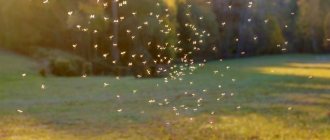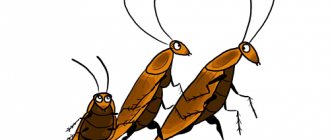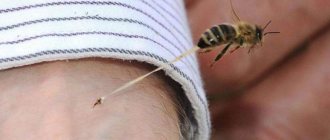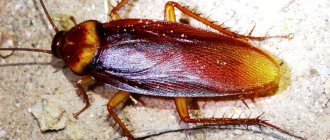Cockroaches die on their backs
Since cockroaches are insects adapted to rough terrain, when they find themselves in rough areas, they are more likely to roll over on their backs. If there is no small debris nearby for them to grab onto with their feet, they are unlikely to be able to return to their original position. Pesticide disposal products contain substances that cause muscle paralysis in cockroaches. Due to uncontrollable spasms, cockroaches turn over and die on their backs.
What are the signs of an allergic reaction to cockroaches?
- Sneezing.
- Runny nose.
- Pain in the nasal cavity and eyes.
It is worth noting the fact that black cockroaches emit an unpleasant odor.
When there are not very many of them in the apartment, the smell is not noticeable, but when they multiply and there are more of them, the apartment begins to smell unpleasant. The method of getting rid of the smell is very simple - first of all, you need to get rid of the “culprits” themselves and then clear the apartment of their remains. It is necessary to carry out a general cleaning of the apartment (thoroughly rinse all hard-to-reach corners, baseboards and under them, walls, since all these “remains” can accumulate in your apartment for many years) and voila, there is a pleasant aroma in your apartment.
Cockroaches without a head
Without the head, the body's systems continue to function. Based on this, we can conclude that cockroaches can live without a head for a sufficient amount of time. But although a cockroach can live without a head, without it it cannot drink or eat, so it still dies within 9 days. A cockroach's organs work even without a head. Therefore, we can say that the head is an accessory for the cockroach and a way of eating. Therefore, at this time, the quality of life of a cockroach without this part of the body will not change.
Interesting facts about cockroaches
Cockroaches are generally considered to be one of the most disgusting pests you can find in your home. They are capable of spreading diseases through feces and multiplying rapidly. Here are some more interesting facts about cockroaches that few people know:
- They appeared on Earth for hundreds of millions of years and may even predate the birth of dinosaurs.
- Cockroaches continue to be one of the most numerous creatures on the planet. There are over 4,600 different species worldwide, but only 30 of them are considered pests.
Photo: www.cockroachfacts.com
- Cockroaches are adaptable, able to find food and a way to survive even in the harshest conditions. These hardy insects have survived global catastrophes and managed to settle on almost all continents.
- Each species of cockroach has its own life expectancy, but on average cockroaches live for about a year. Factors such as food availability, habitat and climate affect their lifespan. American cockroaches can live for about a year, while German cockroaches are estimated to live for about 100 days.
- On average, cockroaches can live without food for a month, but without water - only a week. Cockroaches can feed on a variety of substances, so starving cockroaches is not effective as a means of pest control.
- Cockroaches can accelerate to 5 km/h, which is very fast for a small insect. If they were the size of a person, they could run at speeds of over 160 km/h; and if a horse could run as fast as a cockroach, it would cover approximately 135 meters per second!
- Cockroaches prefer darkness for searching for food and mating. That's why you usually see them when you turn on the lights at night.
- Cockroaches reproduce quickly. Some females mate only once but then spend the rest of their lives pregnant. Cockroach eggs are small and vary in color, but most species hide their eggs very well.
- The cockroach is omnivorous, but prefers sweets, meat products and starch. However, you may also see them eating leather or books on shelves. If their food supply is limited, they may bite people. The American cockroach, oddly enough, shows a noticeable attraction to alcoholic beverages, especially beer. He is probably attracted to hops and sugar, which are the main ingredients in beer.
Photo: www.impactpest.com
- Their bodies are designed to squeeze into tiny cracks and cracks. Even the smallest hole can allow cockroaches to enter your home.
- Cases have been recorded of headless cockroaches living for a week! Due to their open circulatory system and the fact that they breathe through small openings in each of their body segments, their breathing does not depend on the mouth or head. The headless cockroach dies from dehydration because without a mouth it cannot drink water.
- Cockroaches love to be in warm places, which is why your home or heated building is so attractive to them. At the same time, they hide closer to food and water.
- All cockroaches go through three stages of development: egg, nymph and adult. The eggs are in shells called ootheca, which reliably protect the cockroach offspring from the environment. After hatching, cockroaches become nymphs and go through several stages of molting until they become adults. Some species even develop wings.
- The cockroach's mouth is one of the most primitive in the animal kingdom. It consists of four parts:
- The upper lip is the outer part of the mouth that squeezes food and directs it to the part that does all the real hard work.
- Mandibles are real jaws. They chew and grind food for digestion.
- The maxillae are a secondary part of the jaws. They are usually covered with fine teeth and are also used for chopping and chewing food, but can also act as small handles to hold and move food.
- The hypopharynx is the tongue that guides food into the esophagus.
Photo: REDMOND DURRELL/ALAMY STOCK PHOTO
- The rhinoceros cockroach is the largest species, capable of growing up to 8 cm in length. They are found only in North Queensland, Australia. The heaviest recorded specimen weighed 33 grams.
- Madagascar hissing cockroaches are popular pets. They release air from their spiracles, making a hissing sound.
- The Chinese eat fried and candied cockroaches, believing that they provide significant health benefits.
- A cockroach can live underwater for up to half an hour. Their ability to hold their breath helps regulate water loss. Cockroaches can hold their breath for up to seven minutes. Their respiratory system is very efficient, but they do not have lungs. Instead, insects draw in air through external valves called spiracles and transport air directly to their cells through tubes called tracheae. To stop breathing underwater, they simply close their spiracles.
- The German cockroach is the most common of all the species, and this type has been implicated in outbreaks of many diseases and allergic reactions in many people. Newborn German cockroaches become adults in just 36 days.
- Some types of cockroaches are specially raised for pharmaceutical purposes, for pet food, and for cleaning organic waste.
Cockroaches and allergies
Allergy to cockroaches is a common type of allergy. Its causes are associated with contact between insects and humans. Cockroaches live almost everywhere, so allergies can occur both to ordinary cockroaches and to cockroaches that are not common in our region. But they can be used as animal feed or kept as pets.
From the bites of exotic cockroaches (Madagascar t., Marbled t.), urticaria is possible, which manifests itself in the form of a rash of blisters. The lesions become red and itchy. If waste products of cockroaches enter the body through the upper respiratory tract, runny nose, sneezing, and eye inflammation are observed. In rare cases, there is a possibility of asthma.
In children suffering from an allergy to cockroaches, the symptoms are similar to those of acute respiratory viral infection, so it is difficult to determine it immediately. If the food contains waste products of the German, the body responds with the following reactions: pain in the stomach, itching, burning lips, nausea.
If the above allergy symptoms appear, you should immediately consult a doctor, as an allergic reaction can develop into Quincke's edema. In case of swelling, it is necessary to call an ambulance, calm the patient, restore breathing, and apply ice. If you are allergic to a cockroach repellent, you need to ventilate the room, completely get rid of the smell and do a damp cleaning.
There is also an allergy to cockroach poison. When poisons get on the mucous membranes, the human body can respond in various ways, from irritation to severe burns. It all depends on the concentration of the poison and the form of poisoning. Typically the symptoms are: dizziness, nausea, vomiting, weakness.
If it enters the body, you must immediately rinse the stomach, induce vomiting, drink sorbents, and then drink plenty of liquid. Be sure to consult a doctor.
The fight against the Prussians: truth and myths
The fight against cockroaches has been going on for decades. However, due to the large number of myths, people cannot always get rid of parasites once and for all. For example, you can often hear facts about cockroaches that you can destroy them yourself using folk remedies . However, in most cases, traditional methods are not aimed at killing insects, but at repelling them. The parasites will leave the house only for a while, and then return again.
Another myth is that disinfect cockroaches with ultrasonic repellers. However, the effectiveness of such drugs, despite their prevalence, has not yet been proven.
The most effective remedy for these pests has always been and will be a service that poisons cockroaches . With the help of innovative equipment and effective drugs, effective destruction of insects occurs quickly. Moreover, all products used are certified and do not pose any danger to people and pets. SES not only destroys insects, but also prevents their subsequent appearance. Because it identifies ways for them to enter the house and installs disinfection barriers. Another advantage of the service is that you can order apartment disinfection by phone or on the service’s website.
As you can see, not all the facts you hear about cockroaches are true and you should not always trust them.
Lifespan, eggs and how they reproduce
Development of a cockroach from egg to adult
Where there is food and water, there will always be cockroaches. They don't need much to survive and reproduce. Cockroaches reproduce sexually and quickly. Starting with mating games, cockroaches mate.
The female lays cockroach eggs in special bags. Different types of cockroaches deal with eggs in different ways: some carry them with them, others hide them in secluded places. The embryos hatch after 2 weeks and the larvae develop. They molt several times. And then different individuals develop.
The lifespan of domestic cockroaches depends on the availability of water and food near them. In apartments, cockroaches live longer and breed more often.
The lifespan of cockroaches ranges from four months to four years.
What do cockroaches like?
The lifestyle of insects affected their preferences. Arthropods love warmth, comfortable temperatures of 25-30°. When the temperature drops, the metabolic processes of Prussians slow down. Indicators of 15° and below stop the reproductive activity of insects. Negative temperatures cause a state of suspended animation and death. Arthropods prefer damp places. Water is vital for them; it is used to cool the body and wet food.
Cockroaches love dark and secluded places. They are timid by nature, it is this quality that allows them to survive. The food preferences of natural inhabitants are not diverse. They usually eat fallen leaves, plant remains, and finding rotten fruit is a great success. Synanthropic insects expanded their diet with human food. They love sweets, fruits and vegetables, baked goods, and pasta. The taste preferences of pests are used against them. Their sweets are prepared as poisonous baits to destroy the Prussians.
Information. Cockroaches are extremely attracted to beer. The intoxicating drink is often poured into homemade traps.
What do cockroaches eat?
Pests are practically omnivorous, this is due to the structure of their mouthparts. Cockroaches living in apartments, namely black and red ones, will eat leftover food on tables, shelves, and cabinets. If they have a choice in food, they will give preference to those that are enriched with carbohydrates and proteins; it can be mentioned that in houses cockroaches are lovers of sugar. When there is no food left near the cockroaches, they can eat small insects, human feces, or the cockroaches will eat their relatives. Do cockroaches eat people? No.
Cockroaches are carriers of diseases
What is the main danger cockroaches pose?
Free movement not only around the apartment, but also through sewer pipes, ventilation, attics, basements and other hard-to-reach places. When they live there, they collect various bacteria on themselves, which, accordingly, are carried into the house. It should not be surprising that various pathogenic bacteria, fungi and worms settle on the paws of cockroaches. What happens next? Pests bring all this infection to your kitchen table, into cabinets and drawers and other places in your home, into the glasses from which you drink water, and so on.
To be honest, cockroaches are able to feed on waste, human and animal excrement from sewers, therefore, they can be carriers of diseases such as:
- Gastroenteritis;
- Meningitis;
- Dysentery;
- Pneumonia;
- Salmonellosis.
Typically, these types of cockroaches include red and black.
There is a type of cockroach called a sewer cockroach - they spend a lot of time in the sewer, hence the name. And this species is especially dangerous for humans. You cannot know what bacteria the pest has collected in the sewer and what “gift” it left for you on your kitchen table.
Then the chain of infection is quite simple - bacteria left by a cockroach on some surface and unwashed hands with which you touched this surface. Here, infection does not always pass only through the stomach when eating food through which the pest has passed.
Anatomy of a cockroach, what does it have?
On the sides of the cockroach there are eyes, which provide it with compound vision. The oral system is primitive, but cockroaches have teeth sharp enough to grind food. The blood of a cockroach is unusually white in color, and the heart is a tubular organ. Because of this, blood circulates slowly. Although cockroaches have a brain, it is not responsible for regulating the respiratory and digestive systems and is poorly developed. Cockroaches do not have a uterus and reproduce sexually. And the sex of cockroaches can be determined by their size: males are smaller than females.
Why are they afraid of cockroaches?
Among the majority of people there was a hostile attitude towards the Prussians. The fear of cockroaches is justified; it is better to stay away from them. Scientists studied the contents of the paws of the Prussians and found on them:
- 32 types of bacteria;
- 17 fungi;
- helminth eggs.
Arthropods carry dysentery, polio, hepatitis, and diphtheria. Bacteria and viruses contaminate food, ready-made meals, dishes, and furniture. Insects cause short circuits in household appliances. Particles of their chitinous cover often provoke allergies and asthma. The article “Insect Attack: Do Cockroaches Bite?” will tell you about the health hazards.
Information. There have been recorded cases of cockroaches eating the human epidermis. Starving adults gnaw off the skin from their fingers, eyelids, and nose.
What sounds do cockroaches make?
Domestic Prussians can disturb apartment residents with the unpleasant sounds they make when eating solid food. With strong chitinous teeth they grind paper, leather, and fabric. In nature, the Madagascar cockroach is known for its hissing. Sound signals are produced by contracting the abdomen. The air comes out sharply through the spiracles, with a characteristic hiss. Sounds are used by insects to communicate between members of the colony and to scare away predators.
A separate type of sounds are signals during the barracks courtship period. Males flap their wings in front of females and create a chirping sound. It occurs when the leathery elytra rub against the edge of the pronotum. The ability is characteristic of giant South American species.
Do cockroaches affect nature?
You may think it's a stupid question, but it's not that simple. Cockroaches release gases every 15 minutes, even after death they continue to do this for a long time. When you look at the big picture, collectively all the insects on the planet emit gases that make up a fifth of methane emissions. Most of this gas is produced by cockroaches. Thus, they have some impact on nature and warming. Answer: yes, cockroaches contribute to some extent to global warming.
What danger do cockroaches pose to people?
Due to the fact that they begin to crawl out of their shelters at night in search of food, they are not visible in the dark. Only by turning on the light in the kitchen or in any other utility room can you see cockroaches or traces of their activity.
After cockroaches crawl through dirty garbage chutes, landfills and latrines, with the same paws they spread bacteria to the food that people eat. Therefore, these pests are carriers of such dangerous diseases as tuberculosis, typhoid fever, dysentery, salmonellosis, meningitis, gastroenteritis, pneumonia, and hepatitis.
They can also become infected with eggs of different types of helminths, which are dangerous for adults and children.
Insects spread the above-mentioned diseases while crawling on household items or furniture. Particular attention should be paid to the sanitary and hygienic conditions in an apartment or country house if there are cockroaches there.
What other danger do these insects pose to humans?
- they bite;
- cause an allergic reaction in people in the form of bronchial asthma, contact dermatitis, conjunctivitis and allergic rhinitis;
- can get into the ear or nasal canal at night.
Internal structure of a cockroach
The internal structure of a cockroach is quite complex and has a number of distinctive abilities. In particular, anatomy can explain such an amazing property of an insect as the ability to live for a long time without a head.
Digestive system
In the mouth of a cockroach there are jaws designed for holding and chewing food, as well as salivary glands that produce saliva, which softens everything that gets into the mouth. Next, the food enters the crop, where it is partially digested, then into the stomach and, finally, into the intestines. Immediately behind the mouth opening, the foregut begins, in the buccal chamber of which there are 6 teeth for additional grinding of food.
All cockroach excrement is excreted through the anus. Both feces and liquid secretions are sent there, that is, urine, which is collected throughout the body using special channels.
Circulatory system
Cockroaches have an open circulatory system. This means that blood (it is white in these insects) moves freely throughout the body, passing through all internal organs. The blood circulation rate is very low, so cockroaches are sensitive to temperature changes.
Respiratory system
The respiratory system of a cockroach is a structure independent of the brain. On the sides of the abdomen there are small holes - spiracles (10 on each side). A system of tubes (tracheoles) extends from them, which connect to six larger tracheal trunks. The tracheal system runs throughout the body and supplies the internal organs with oxygen. By blocking the spiracles, the cockroach may not breathe for up to 40 minutes.
Nervous system
The nervous system of a cockroach consists of 11 nerve nodes (ganglia). The two largest of them are in the head, responsible for the functions of the whiskers and vision. The thoracic nodes (there are only 3 of them) are responsible for the muscles of the head, thoracic region, legs, wings and oral apparatus. The remaining 6 ganglia of the central nervous system are located in the abdomen, the most recent of which controls the genitals and hearing organs, located next to the anus. A whole system of nerve fibers departs from the ganglia, providing innervation to all organs of cockroaches.
Reproductive system
The reproductive system of cockroaches is quite complex. For a male it is:
- testes;
- utricular gland;
- seminal vesicles;
- external genital plate.
In females:
- ovaries;
- oviducts connected to the vagina;
- the genital chamber in which the eggs are located;
- ovipositor.
Special glands produce a secretion to form the ootheca (the capsule in which eggs develop).
Cockroaches: they're everywhere
There is no person who has not met a cockroach at least once in his life - this is a red insect, it runs quickly, lives in the kitchen, and in catering establishments.
Thanks to their hardiness and resistance to most types of insecticides sold in household chemical stores, cockroaches have managed to quickly spread over a large area. And they don’t want to give up their habitat to anyone, especially to a person who wants to get rid of them.
Even if you meet only 1 cockroach, know that somewhere not far from you there is a colony where there are hundreds and thousands of these pests. Every month, 1 female cockroach can give birth to 50 new individuals - on the scale of a small apartment this is a real natural disaster. If your house or dacha is warm, there are a lot of cracks in the floor, near the baseboards, or there are areas in the kitchen that are hard to reach for cleaning, cockroaches will soon come to you. And they won’t want to leave; they will have to be removed with the help of insecticides.
Structure of a cockroach
Interestingly, the body structure of the cockroach has remained almost unchanged for millions of years. That is, this insect was created almost perfect. The body of cockroaches consists of a head, thorax and abdomen. On the head of the cockroach there is a gnawing mouthpart, covered with a shield, and large compound eyes are located on the sides. Some cockroaches have an additional pair of simple vision organs.
Only a few exotic species of cockroaches can hiss, whistle, or even make sounds that resemble a whisper. But, for example, an ordinary Prussian does not even have the organs necessary for this.
Breast
The chest consists of three segments, each of which has a pair of legs. Also on the chest part there are wings and elytra. The anterior segment of the breast is most often much larger than the other two and has a lighter shade.
Wings
Two pairs of thin wings and hard elytra are attached to the chest, protecting the wings and abdomen. Despite the presence of wings, only one type of cockroach can fly; all the others use them to accelerate while moving or to make the fall slower and smoother. But the main purpose of the wings is to show readiness for mating during mating games. By the way, males have much longer wings than females.
Limbs
A cockroach has the same number of legs as other insects, but their structure can be called unique. Each tarsus consists of 5 segments. The top four have pads, and the fifth has a sucker and claws. Thanks to this structure, the insect moves with ease on both horizontal and vertical surfaces.
The maneuverability and speed of movement of the insect is explained by the fact that each pair of legs has its own characteristics:
- prothoracic - the shortest, play the role of a brake;
- mid-thoracic - can move in different directions;
- metathoracic - the longest, play a major role in moving forward, and are also used for jumping.
Cockroach
A cockroach runs at a speed of 3.5 - 4 km/h. Considering its size, this is a very good indicator. This speed is achieved by one of the fastest animals on the planet – the cheetah.
Abdomen
The abdomen consists of 11 segments, the tenth of which covers the anus, and the eleventh contains the cerci - rudimentary processes that do not serve any function. In females, the abdomen is much larger, since the ovipositor is located in it.











